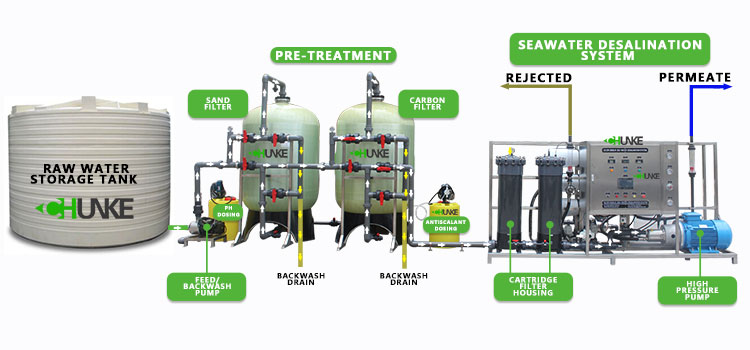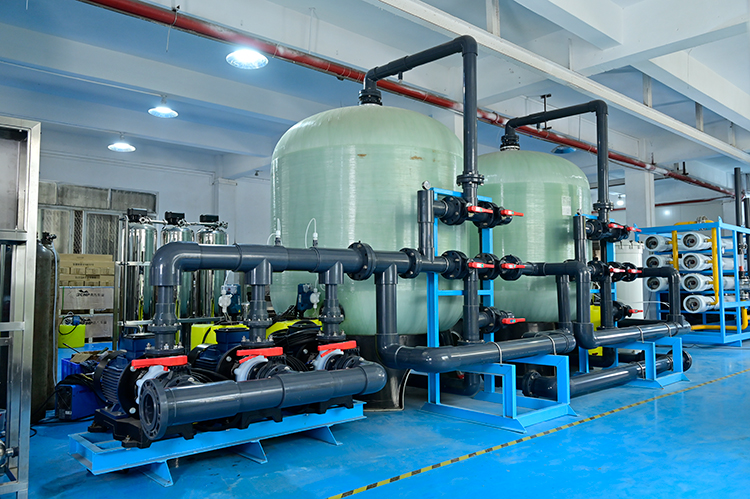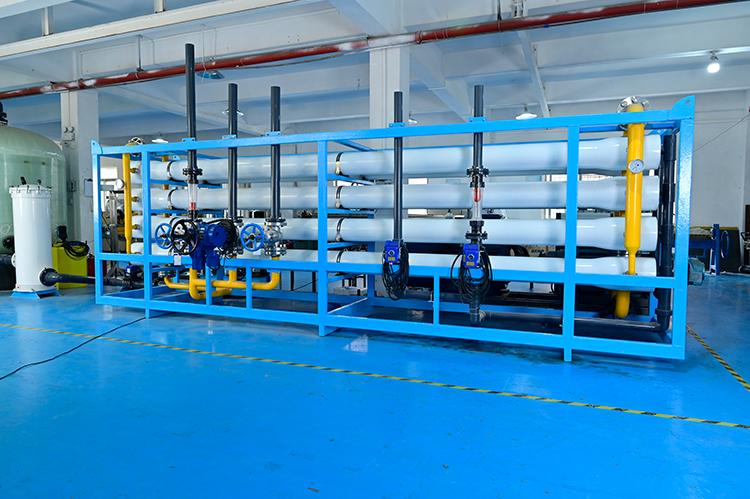Common Troubleshooting Guide for Reverse Osmosis Systems
When using a reverse osmosis (RO) system, you may encounter various faults and problems. Here are some common problems and a guide to troubleshooting and solutions:

1. No water in the RO system:
Possible causes:
Water inlet valve is closed: Check if the water inlet valve is closed and make sure to open the water inlet valve.
Water inlet pipe is blocked or damaged: Check if the water inlet pipe is blocked or damaged. This can be checked by checking if there are foreign objects or damage at the water pipe connection.
Insufficient water inlet pressure: Check if the water inlet pressure is normal. You may need to use a pressure gauge to test the water pressure.
Solution:
● If the water inlet valve is closed, gently turn on the water inlet valve.
● If the water inlet pipe is found to be blocked or damaged, you need to turn off the water source first and use appropriate tools (such as pipe cleaners) to clear the blockage or repair the damage.
● If the water inlet pressure is insufficient, you can consider installing a booster pump or adjusting the water pressure control device.
2. Slow water flow through the faucet:
Possible causes:
Insufficient water inlet pressure: Check if the water inlet pipe and water inlet valve are normal and ensure that there is enough water pressure to supply the RO system.
Filter element is clogged: Check if the pre-filter element needs to be replaced. You may need to close the water inlet valve and remove the filter element for cleaning or replacement.
Faucet nozzle is clogged: Remove the faucet nozzle and clean or replace the clogged part.
Solution:
● When checking for insufficient water inlet pressure, you need to be careful to handle the water pipe connection to avoid damage.
● When removing the filter element and faucet nozzle, make sure to use appropriate tools and techniques to prevent damage to related parts.
3. Leakage of membrane housing:
Possible reasons:
The membrane housing is not sealed tightly or the membrane element is damaged.
Solution:
● First, close the water inlet valve of the RO system to stop the water supply.
● Carefully remove the membrane housing with appropriate tools and check whether the seal is intact. If the seal is found to be damaged or aged, it needs to be replaced in time.
● Check whether the RO membrane has obvious damage or cracks, and replace the new RO membrane element if necessary.
● When reinstalling the membrane housing, ensure that the seal is installed correctly and apply sealant appropriately to ensure sealing.

4. RO filter housing leaks:
Possible causes:
The filter housing is not sealed tightly or the filter itself is damaged.
Solution:
●First, turn off the water inlet valve of the RO system and stop the water supply.
●Carefully disassemble the filter housing and check whether the sealing ring is intact. If the sealing ring is damaged or aged, it needs to be replaced in time.
●Inspect the filter itself for damage or cracks and replace it with a new filter element if necessary.
●When reinstalling the filter housing, ensure that the sealing ring is installed correctly and apply sealant appropriately to ensure the seal.
5. Faucet leaks:
Possible causes:
The internal seal of the faucet is damaged.
Solution:
●Turn off the faucet and disconnect the water supply.
●Use appropriate tools to disassemble the faucet and check whether the internal seal is damaged or aged. If necessary, replace it with a new seal.
●When reinstalling the faucet, ensure that the seal is installed correctly and apply sealant appropriately to ensure the seal.
6. Bad taste or odor:
Possible causes:
Contaminants or chemicals in the water source.
Solution:
● Use a water quality test tool to test the water quality of the RO system to determine whether it is contaminated.
● If necessary, replace the pre-filter of the RO system, such as the activated carbon filter, to reduce pollutants and odors in the water.
7. Turbid ice or milky water:
Possible causes:
Suspended matter or microorganisms in the water.
Solution:
● First, turn off the ice maker or water dispenser and disconnect the water supply.
● Clean the water tank and pipes of the ice maker or water dispenser to ensure that there is no dirt or bacteria remaining.
● If there is a problem with the water source itself, consider installing additional water filters or disinfection equipment.
8. The drain pipe or faucet is noisy:
Possible causes:
Loose water pipes or connectors, high water pressure, and damaged internal parts of the faucet.
Solution:
● Check whether the connectors of the drain pipe and faucet are loose, and tighten them with a wrench or spanner.
● Adjust the water pressure control device of the RO system to ensure that the water pressure is within the normal range.
● Check whether the internal parts of the faucet are damaged, and replace the internal parts if necessary.

9. Joint leakage:
Possible causes:
Poor joint seal, joint damage.
Solution:
●First, close the water inlet valve of the RO system and disconnect the water supply.
●Check the sealing of the joint and reinstall or replace the seal if necessary.
●Check whether the joint itself is damaged or cracked, and replace it with a new one if necessary.
10. The system continues to run:
Possible causes:
The water inlet valve is not closed, the system is leaking, and the pressure control device is faulty.
Solution:
●Make sure the water inlet valve is completely closed and check for signs of water leakage.
●Check whether the pressure control device is operating normally and adjust or replace it if necessary.
11. The ice maker does not work:
Possible causes:
The water supply is interrupted, the ice maker is faulty, and the ice maker parts are damaged.
Solution:
●Check whether the water supply of the ice maker is normal and ensure that the water supply is unobstructed.
●Check whether the power connection of the ice maker is stable and ensure that the power supply is normal.
●Check whether the internal parts of the ice maker are damaged or need cleaning and maintenance, and repair or replace them if necessary.
12. Refrigerator water dispenser does not work:
Possible causes:
Water supply interruption, refrigerator water dispenser failure, water pipe connection problem.
Solution:
●Check whether the water supply of the refrigerator water dispenser is normal and ensure that the water supply is unobstructed.
●Check whether the power connection of the refrigerator water dispenser is stable and ensure that the power supply is normal.
●Check whether the water pipe connection is loose or damaged, and repair or replace it if necessary.
When dealing with these problems, make sure to be careful during the operation, especially when removing and reinstalling the equipment, to avoid damage to the equipment or personal injury. If you are confused or unsure about the troubleshooting and solution of the problem, it is best to consult a professional water treatment technician or supplier for help and guidance.




